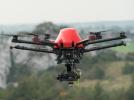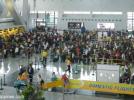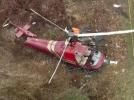ANA B737 near Hamamatsu on Sep 6th 2011, violent left roll while opening cockpit door injures 2 cabin crew
The JTSB released their final report concluding the probable causes of the serious incident were:
It is highly probable that this serious incident occurred in the following circumstances: During the flight, the FO erroneously operated the Rudder Trim SW while having an intention of operating the Door Lock Selector in order to let the PIC reenter the cockpit. The aircraft attitude became unusual beyond a threshold for maintaining the aircraft attitude under the autopilot control. The FO’s recognition of the unusual situation was delayed and his subsequent recovery operations were partially inappropriate or insufficient; therefore, the aircraft attitude became even more unusual, causing the Aircraft to lose its lifting force and went into nosedive. This led to a situation which is equivalent to “a case where aircraft operation is impeded.” It is probable that the followings contributed to the FO’s erroneous operation of the Rudder Trim SW while having an intention of operating the Door Lock Selector; he had not been fully corrected his memories of operation about the Door Lock Selector of the 737-500 on which he was previously on duty; the Door Lock Selector of the 737-500 was similar to the Rudder Trim SW of the 737-700 in their placement, shape, size and operability. It is somewhat likely that his memories of operation about the Door Lock Selector of the 737-500 had not been fully corrected because he failed to be fully accustomed with the change in the location of the Door Lock Selector. It is somewhat likely that this resulted from lack of effectiveness in the current system for determining the differences training contents and its check method, under which the Company and other air carriers considered and adopted specific training programs to train pilots about how to operate the flight deck switches when their locations changed and the Civil Aviation Bureau of the Ministry of Land, Infrastructure, Transport and Tourism reviewed and approved them. It is probable that the FO’s failure to properly manage tasks contributed to his erroneous operation of the Rudder Trim SW. It is somewhat likely that the similarities between the Door Lock Selector and the Rudder Trim SW in their operability contributed to the delay in his recognition of the erroneous operation. Moreover, he was excessively dependent on autopilot flight and he failed to be fully aware of monitoring the flight condition.
It is somewhat likely that the FO’s recovery operations were partially inappropriate or insufficient because he was startled and confused on the occurrence of an unexpected unusual situation in which the stick shaker was activated during the upset recovery maneuver. It is somewhat likely that the followings contributed to his startle and confusion: he had not received upset recovery training accompanied with a stall warning and in unexpected situations, thereby he lacked the experience of performing duties in such situations before the serious incident, and he had not received upset recovery training at a high altitude.
Other Findings on Safety-related Matters
After the occurrence of this serious incident, the Company used the Aircraft for actual flights before the completion of all necessary special inspections. But no abnormal condition was found when the special inspections were performed. Therefore, it is probable that there was actually almost no risk in safe flight operations. However, it is probable that the implementation of the special inspections was confused by factors related to the process the persons involved had to undergo at that time, from the acquisition and transfer of the relevant information to the investigation and scrutiny of the data.
It is probable that the fact that necessary information was not conveyed from the PIC to Mechanics because of his failure to properly sort out the events which occurred aboard the Aircraft was involved with the confusion in the implementation of the special inspections.
It is somewhat likely that because the Company’s judgment on whether to make a special inspection for the Aircraft greatly depended on the PIC’s report, actions for inspection and analysis proved to be too late; consequently, the subsequent inspection process was confused.
As described in 2.12.3, the Company’s OM prescribes, “In the event that one of the pilots leaves his/her seat in the cockpit at an altitude of 25,000 feet or above, the other pilot shall use his/her oxygen mask until he/she comes back.” Because the Aircraft was cruising at an altitude of 41,000 ft when the PIC left the cockpit, the provision can be applied to this case. However, as described in 2.1.2 (2), the FO did not wear and use an oxygen mask while the PIC was absent from the cockpit, according to his statement. He knew that there was a provision for crew members to use oxygen masks in this situation, but he did not do so.
The JTSB analysed that the first officer was entering a route change into the flight management system's CDU and executed the change, during the time of 14 seconds while entering the data and executing the change the door signal occurred. The JTSB analysed: "According to the FO, when pilots leave the cockpit to use the restroom, they are usually absent for one minute or so; therefore, it would have been possible for the FO to operate the CDU after waiting for the PIC to return. If the FO had not executed made this operation, he could have concentrated on unlocking the cockpit door after receiving the PIC’s signal and confirming his face. Accordingly, the possibility of an erroneous operation, such as seen in this incident, was believed to be smaller in these circumstances."
3 seconds after pressing the EXEC button the first officer operated the rudder trim switch. The JTSB analysed: "These matters can be taken to suggest that before fully confirming the results of his own flight controls (for executing the route change on the CDU), the FO turned his eyes to the monitor screen and confirmed the PIC’s face, and then tried to operate what he perceived to be the Door Lock Selector."
The EXEC button activated a right hand turn, the control wheel turned right. The JTSB analysed: "As described in 2.12.2, in view of the “Fly First” principle, the FO “must make efforts to maintain an appropriate aircraft attitude, speed, altitude, and configuration via steering operations.” Therefore, these actions are believed to be indispensable and top priority tasks. It is considered that the FO should have concentrated on monitoring the aircraft attitude (the result of his operations for flying) in this incident until the Wheel returns almost to the neutral position with the series of flight controls finished in order to obtain a minimum necessary roll angle for the route change. It is probable that if the tasks had been properly managed, the FO would have operated the Door Lock Selector after completing the series of flight controls and it is probable that the FO would have been able to fully confirm the Door Lock Selector. In addition, it is somewhat likely that if the FO was aware of the need to concentrate on monitoring the result of his flight controls, and even when he made an error in these operations, he would have recognized the failure of the Wheel to return toward the neutral position due to the effects of the displacement of the Rudder. It is somewhat likely that he could have taken some action at this point to keep the Aircraft from falling into an unusual attitude, for example, by discontinuing the action to operate the Rudder Trim SW. In other words, the FO attempted to operate the Door Lock Selector without finishing a series of flight controls which were top priority tasks for him. As a result, it is highly probable that he set into a situation where two tasks had to be performed at the same time. In these circumstances, it is somewhat likely that the FO operated the switch without fully confirming it as the Door Lock Selector, or he rotated the switch as the result of his memories of operation about the Door Lock Selector for the 737-500 remained uncorrected, as described in 3.2.2, which were brought out at that time. Moreover, it is somewhat likely that the FO did not recognize the unusual movement of the Wheel. Based on these findings, it is probable that the erroneous rotation was caused by the fact that the FO failed to properly manage his tasks, while prioritizing plural tasks, if any, before implementing, rather than executing them all at once, and giving top priority to flight controls, and even when other operations must be executed, paying maximum possible attention to flight controls."
The JTSB analysed (answering whether the autopilot remained engaged throughout the upset and recovery): "While the FO was performing the series of recovery operations in this case, the autopilot and auto-throttle systems remained engaged. Meanwhile, as described in 2.9.3 in the table “Nose Low Recovery” in the AOM, when an upset situation occurred while flying with autopilot and auto-throttle engaged, these systems must be disengaged. It is probable that this rule is based on the belief that when an upset situation occurs while flying with autopilot and auto-throttle engaged, the systems, both or either of them, might not be working properly. When pilots intentionally disengage autopilot, they must press down a disengage button attached to the Wheel or a similar button on the MCP panel located above the PFD. As described in 2.1.2 (2), the FO had his hands full with quickly correcting the aircraft attitude by rotating the Wheel and because he could not afford to disengage the autopilot, he was trying to correct the attitude by overriding autopilot, according to his statement."
The JTSB analysed: "As described in 2.1.2 (2), the FO heard the PIC attempting to open the cockpit door several times after the start of his recovery operations, but he concentrated on making operations to correct the aircraft attitude, according to his statement. It is highly probable that the PIC attempted to open the door at the time after sending a predetermined signal to the FO again and before the PIC’s reentry. In this investigation, it could not be determined whether the PIC’s attempt to open the door had anything to do with the FO’s recovery operations. But, as described also in 2.1.2 (2), the FO’s memories were ambiguous about what happened during his recovery operations, as illustrated by his lack of memories about whether the stick shaker was activated and how much the bank was, but he did have memories about the PIC’s attempt to open the door. This means that the attempt by the PIC was deeply etched in his mind and it cannot be denied that this had some influence on his behavior. Therefore, it is somewhat likely that the PIC’s attempt to open the cockpit door prevented the FO’s calm judgment."
http://avherald.com/h?article=4428f2f7/0000














Komentarze